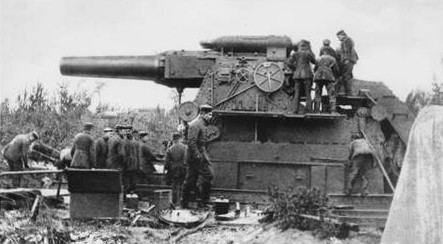Type Siege gun In service 1909–45 | Place of origin German Empire Designer Krupp | |
 | ||
Used by German Empire
Nazi Germany Wars World War I
World War II | ||
The 42 cm Gamma Mörser as it was known in World War II or, originally, kurze Marinekanone L/16 (short naval gun with 16-caliber barrel) was a German siege howitzer. It was one in a series of super-heavy siege guns developed by Krupp before World War I. During the war, the gun was used to attack fortresses in Belgium, France and Poland. The sole howitzer that survived World War I was used in World War II to attack the Maginot Line and the fortress of Sevastopol.
Contents
Design and history
Well before World War I, Krupp began development of a series of super-heavy siege guns intended to crack the armored fortresses being built by Germany's neighbours. The Gamma was the third major design in this series, hence the name of Gamma-Gerät (Gamma device), and was basically an enlarged 30.5 cm Beta-Gerät. The Krupp company also had relevant prior experience building 42 cm guns; a 33-calibre, 122-ton, brown powder coastal gun had even been exhibited in Chicago at the 1893 World's Columbian Exposition. (This was a rebored 40 cm test gun that had served as prototype for the four 40 cm L/35 guns of 121 tons delivered to Italy for mounting in coastal twin turrets at La Spezia and Taranto.)
For transport, the Gamma broke down into ten loads. It was a Bettungsgeschütz (bedding-gun) that had to be fired from a concrete platform. This was a tactical limitation and demanded extensive planning since the concrete had to cure, which could take up to a week, before the Gamma could be assembled. Assembly took a couple of days before it was ready to fire, even with the aid of a rail-mounted traveling crane.
The impetus from the German General Staff to equip the army with large siege gun first came from one young officer, Max Bauer, who soon after his 1905 (initially temporary) appointment to the Fortress Department of the Staff, started to lobby his superiors. He soon won over Erich Ludendorff, and he engaged in correspondence with Rausenberger of Krupp. By April 1909, a 42 cm prototype was ready for test firing at Krupps. Based on Bauer's correspondence, these tests were apparently very promising. In early 1911, the gun was delivered for more testing by artillery proving experts. These tests also impressed Ludendorff, who was now head of the Mobilization Department of the Staff, and transferred Bauer to a permanent assignment in his own department. The new gun even persuaded Ludendorff to resurrect the idea of smashing through France's fortress wall in a double envelopment move. Ludendorff proposed to attack the massive fort complexes of Verdun and Toul-Nancy in addition to the assault on Belgium, which had been the doctrinaire orthodoxy of the Schlieffen Plan for about 15 years. Ludendorff calculated that his alternative required eight 42 cm Gamma Devices and 16 Beta 30.5 cm mortars. However, the War Ministry Artillery Department, especially Karl Justrow, were skeptical of the mobility of the Gamma gun, as well as of the ammunition costs of Ludendorff's double envelopment plan. The Ministry wanted a more mobile 42 cm howitzer, and placed its own orders for a 44-ton howitzer, the M-Gerät ("M device", but popularly known as Dicke Berta), which was less powerful and had shorter range, but was transportable by tractors over land, while the Gamma device required railroads. An angry compromise resulted, in which both types were built. Between 1913 and 1914, four more Gamma Devices were built, (raising the pre-war production total to five), and two M Devices were also built in this period. Five more Gamma devices were built during the war.
Like the Beta-Gerät, it was virtually unique among German World War I–era artillery in using a Welin interrupted-screw breech. It used a cartridge case even though its breech design did not require one to provide the necessary seal to prevent the escape of combustion gases. Possibly this was done to speed up its rate of fire, or because virtually every other German artillery piece used cartridge cases rather than bagged powder. It used a loading system to move ammunition from the ground up to the breech.
An armored gunhouse for protection against shell fragments (Splitterschutz-Panzerkasten) could be fitted, and at least the Becker battery (KMK no. 2) was photographed deployed this way during the 1914 campaign in Belgium. The surviving gun gained a much more elaborate firing platform. It is unclear what other changes the Germans made to the surviving gun. It was hidden at Krupp's proving ground at Meppen and was recommissioned during the 1930s to test concrete-piercing rounds. The Germans deployed it against the Maginot Line, and at the Siege of Sevastopol.
Ammunition
Details are lacking on the ammunition it used during the First World War, other than it used two different shells, the original HE shell of 1,953 pounds (886 kg) at some 1,200 feet (370 m) per second and a lighter 1,680 pound (760 kg) shell that it shared with its successor, the 42 cm howitzer commonly called Big Bertha.
In World War II, it used a concrete-piercing shell (42 cm Sprgr Be) weighing 1,003 kilograms (2,211 lb), propelled by up to four increments of powder, weighing in total 77.8 kilograms (172 lb).
